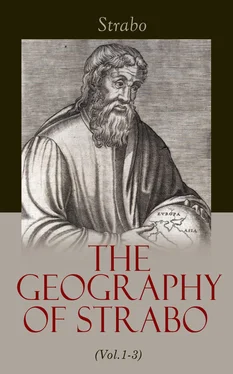16. Such being the configuration of the whole earth, it will be convenient to take two straight lines, cutting each other at right angles, and running the one through its greatest length, and the other through its breadth. The former of these lines will represent one of the parallels, and the latter one of the meridians. 755Afterwards we must imagine other lines parallel to either of these respectively, and dividing both the land and sea with which we are acquainted. By this means the form of the habitable earth will appear more clearly to be such as we have described it; likewise the extent of the various lines, whether traced through its length or breadth, and the latitudes [of places], will also be more clearly distinguished, whether north or south, as also [the longitudes] whether east or west. However, these right lines should be drawn through places that are known. Two have already been thus fixed upon, I mean the two middle [lines] running through its length and breadth, which have been already explained, and by means of these the others may easily be determined. These lines will serve us as marks to distinguish countries situated under the same parallel, and otherwise to determine different positions both in respect to the other portions of the earth, and also of the celestial appearances.
17. The ocean it is which principally divides the earth into various countries, and moulds its form. It creates bays, seas, straits, isthmuses, peninsulas, and capes; while rivers and mountains serve to the same purpose. It is by these means that continents, nations, and the position of cities are capable of being clearly distinguished, together with those various other details of which a chorographical chart is full. Amongst these latter are the multitude of islands scattered throughout the seas, and along every coast; each of them distinguished by some good or bad quality, by certain advantages or disadvantages, due either to nature or to art.
The natural advantages [of a place] should always be mentioned, since they are permanent. Advantages which are adventitious are liable to change, although the majority of those which have continued for any length of time should not be passed over, nor even those which, although but recent, have yet acquired some note and celebrity. For those which continue, come to be regarded by posterity not as works of art, but as the natural advantages of the place; these therefore it is evident we must notice. True it is, that to many a city we may apply the reflection of Demosthenes 756on Olynthus and its neighbouring towns: “So completely have they vanished, that no one who should now visit their sites could say that they had ever been inhabited!”
Still we are gratified by visiting these and similar localities, being desirous of beholding the traces of such celebrated places, and the tombs of famous men. In like manner we should record laws and forms of government no longer in existence, since these are serviceable to have in mind, equally with the remembrance of actions, whether for the sake of imitating or avoiding the like.
18. Continuing our former sketch, we now state that the earth which we inhabit contains numerous gulfs, formed by the exterior sea or ocean which surrounds it. Of these there are four principal. The northern, called the Caspian, by others designated the Hyrcanian Sea, the Persian and Arabian Gulfs, formed by the [Southern] Sea, the one being nearly opposite to the Caspian, the other to the Euxine; the fourth, which in size is much more considerable than the others, is called the Internal and Our Sea. 757It commences in the west at the Strait of the Pillars of Hercules, and continues in an easterly direction, but with varying breadth. Farther in, it becomes divided, and terminates in two gulfs; that on the left being called the Euxine Sea, while the other consists of the seas of Egypt, Pamphylia, and Issus. All these gulfs formed by the exterior sea, have a narrow entrance; those of the Arabian Gulf, however, and the Pillars of Hercules are smaller than the rest. 758The land which surrounds these, as before remarked, consists of three divisions. Of these, the configuration of Europe is the most irregular. Libya, on the contrary, is the most regular; while Asia holds a middle place between the two. In all of these continents, the regularity or irregularity of form relates merely to the interior coasts; the exterior, with the exception of the gulfs before mentioned, is unindented, and, as I have stated, resembles a chlamys in its form; any slight differences being of course overlooked, as in large matters what is insignificant passes for nothing. Since in geographical descriptions we not only aim at portraying the configuration and extent of various places, but also their common boundaries, we will remark here, as we have done before, that the coasts of the Internal Sea 759present a greater variety in their appearance than those of the Exterior [Ocean]; the former is also much better known, its climate is more temperate, and more civilized cities and nations are here than there. We are also anxious to be informed where the form of government, the arts, and whatever else ministers to intelligence, produce the greatest results. Interest will always lead us to where the relations of commerce and society are most easily established, and these are advantages to be found where government is administered, or rather where it is well administered. In each of these particulars, as before remarked, Our Sea 760possesses great advantages, and here therefore we will begin our description.
19. This gulf, 761as before stated, commences at the Strait of the Pillars; this at its narrowest part is said to be 70 stadia. Having sailed down a distance of 120 stadia, the shores widen considerably, especially to the left, and you behold a vast sea, bounded on the right by the shore of Libya as far as Carthage, and on the opposite side by those of Iberia and Keltica as far as Narbonne and Marseilles, thence by the Ligurian, 762and finally by the Italian coast to the Strait of Sicily. The eastern side of this sea is formed by Sicily and the straits on either side of it. That next Italy being 7 stadia [in breadth], and that next Carthage 1500 stadia. The line drawn from the Pillars to the lesser strait of 7 stadia, forms part of the line to Rhodes and the Taurus, and intersects the sea under discussion about its middle; this line is said to be 12,000 stadia, which is accordingly the length of the sea. Its greatest breadth is about 5000 stadia, and extends from the Galatic Gulf, between Marseilles and Narbonne, to the opposite coast of Libya.
The portion of the sea which washes Libya is called the Libyan Sea; that surrounding the land opposite is designated by the respective names of the Iberian, the Ligurian, 763and the Sardinian Seas, while the remaining portion as far as Sicily is named the Tyrrhenian Sea. 764All along the coast between the Tyrrhenian and Ligurian Seas, there are numerous islands, the largest of which are Sardinia and Cyrnus, 765always excepting Sicily, which is larger and more fertile than any of our islands. The remainder are much smaller. Of this number are, in the high sea, Pandataria 766and Pontia, 767and close to the shore Æthalia, 768Planasia, 769Pithecussa, 770Prochyta, 771Capriæ, 772Leucosia, 773and many others. On the other 774side of the Ligurian shore, and along the rest of the coast as far as the Pillars, there are but few islands; the Gymnasiæ 775and Ebusus 776are of this number. There are likewise but few islands along the coasts of Libya and Sicily. We may mention however Cossura, 777Ægimurus, 778and the Lipari Islands, likewise called the Islands of Æolus.
20. After Sicily and the straits on either side of it, 779there are other seas, for instance, that opposite the Syrtes and the Cyrenaic, 780the Syrtes themselves, and the sea formerly called the Ausonian, but which, as it flows into and forms part of the Sea of Sicily, is now included under the latter name. The sea opposite to the Syrtes and the Cyrenaic is called the Libyan Sea; it extends as far as the Sea of Egypt.
Читать дальше












![Anne Blunt - A Pilgrimage to Nejd, the Cradle of the Arab Race. Vol. 2 [of 2]](/books/750183/anne-blunt-a-pilgrimage-to-nejd-the-cradle-of-the-thumb.webp)